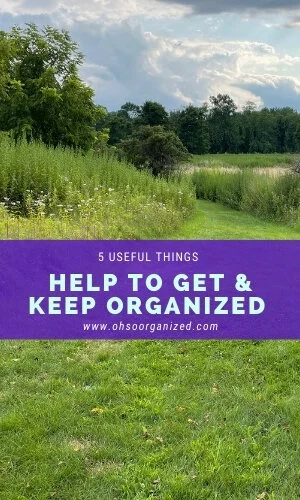For almost three decades, I’ve enthusiastically helped people edit and get organized. Recently, I’ve become my own client and leaned into some organizing self-help. My motivation to let go of the extraneous was partially influenced by this summer’s tiny house vacation. While I no longer am obsessed with moving into a tiny house, I want to live in our right-sized house, but with less stuff.
Our home isn’t disorganized or cluttered. Things have a place. My husband, Steve, and I can easily retrieve and return items to their designated ‘homes.’ However, there are belongings that have overstayed their welcome. Those are the things that have been stored for a long time and are no longer used, needed, or wanted. They are taking up physical and emotional space. Their time has come to move on.
After returning from vacation, I set a long-term goal to reduce the amount of stuff I own. My plan isn’t a detailed room-by-room-do-this-by-x-date proposition. It’s a low-pressure, loose plan. I added one simple daily repeat on my to-do list that says, “Edit & release some stuff.” There is no expectation other than to do something. I spend 15-60 minutes editing what I feel like working on that day.
In the last two weeks, I edited and organized clothing, shoes, handbags, toiletries, cleaning products, paper goods, dishes, and glasses. Additional edits included candles, vases, office supplies, books, photos, cards, letters, memorabilia, personal and business files, and email inbox. These items were from the dining room, entryway, laundry room, kitchen, office, main bedroom, and bathrooms.
I let go of
Five 13-gallon bags of trash
Two 30-gallon bags of trash
Two 30-gallon bags of clothing and home goods for donations
One bag of books for donations
One bag of paper for recycling
One bag of paper for shredding
One container of pens for a friend
Like with all experiments, come learning. My ‘edit & release some stuff’ plan is no exception. There will be more insights, but here are seven discoveries I made so far.
7 Best Organizing Self-Help Discoveries Made With My New Simple Plan
1. Track Your Progress
There are many ways to enjoy progress, but for me, tracking with a simple chart helps me review and acknowledge my accomplishments. I created a Word document with three columns- date, area worked on, and result. Taking photos or journaling can also be helpful.
2. Respect Random Approach
Typical organizing wisdom encourages us to organize one area before moving on to the next. I’ve shared that advice with many clients. However, as logical as that sounds, it’s not always possible or desirable. Clients sometimes get bored working in one area or encounter emotionally charged belongings they are not ready to organize. With my approach, I gifted myself the option for randomness. Instead of a specific plan of what to edit each day, I let myself choose more intuitively. Which area do I feel like working on today? It keeps the pressure low and the satisfaction high.
3. Honor Your Emotions
Is organizing emotional? It can be. While editing, I experienced a range of feelings like happiness, joy, sadness, ambivalence, resistance, frustration, annoyance, guilt, exhaustion, satisfaction, and love. I let my emotions have the space to surface. When editing my cards, I found a beautiful, love-filled note written by my mom for my 40th birthday. I felt sad that she is gone and simultaneously felt her love and encouragement.
4. Trust the Exit
Honestly, if I wasn’t logging my progress and noting the stuff I said goodbye to, I wouldn’t remember what was gone. I have no regrets and don’t miss anything that I released. It feels good.
“It’s liberating to live with less.”
5. Live With Less
As each area or space is edited, I appreciate having less. For example, when I open the sticky note drawer, only my favorites are there, and the never-used ones are gone. When I get dressed, the clothes I like and wear most are in my closets and drawers. They have space to breathe, and it makes it easier for me to select what I’m going to wear. It’s liberating to live with less.
6. Rethink Your Space
One of the benefits of letting go is the opportunity to rethink your space. Having less visual and physical clutter makes it easier to improve flow and organization. As I released stuff, I cleaned and asked a few questions. Is the space working as is? Or, could it use a slight tweak? Some areas were set. However, for others, I made improvements. For example, after the kitchen edit, I inserted freestanding cabinet shelves. This made use of wasted vertical space and also improved access to frequently used dishes.
7. Engage Self or Outside Help
While I’m making progress, I recognize the value of enlisting help. While I have released a lot, I’m pretty sure if someone supported and asked me questions as I edited, I’d let go of more. Help with facilitating decision-making is invaluable. For now, I continue to go it alone, coaching myself through the process. I will leave the door open to reach out for help if needed.
Have you been editing and organizing? Are you doing it on your own or did you get help? What did you learn? Did any of my discoveries resonate with you? I’d love to hear your thoughts. I invite you to join the conversation.











